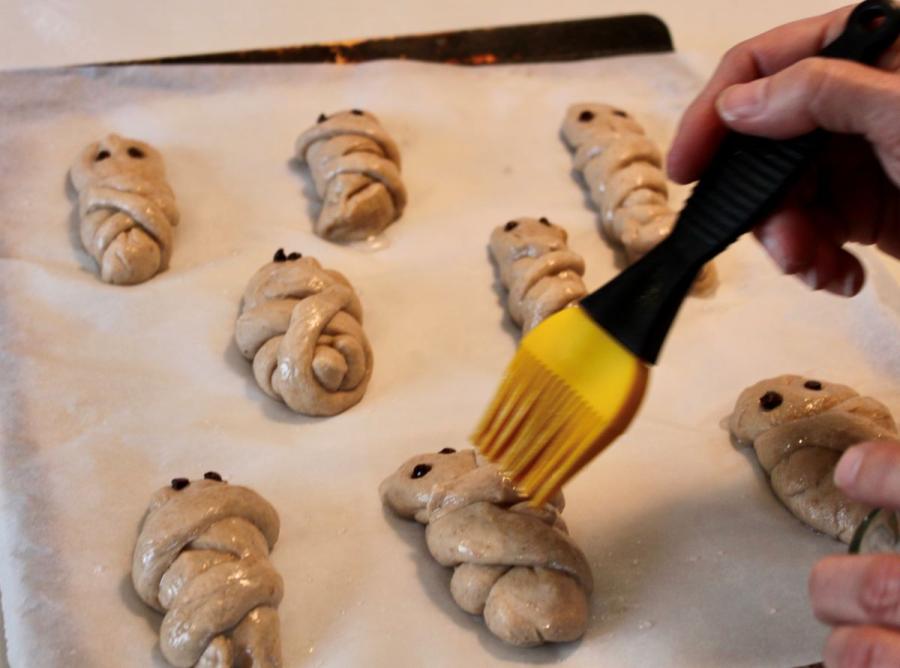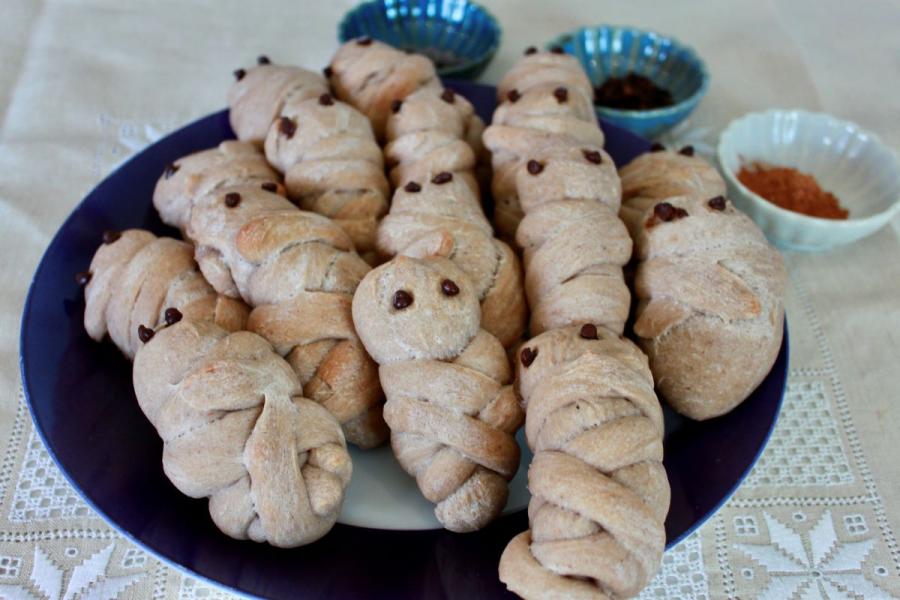Lazarus bread rolls are traditional in many Greek parishes to celebrate Christ's resurrection of Lazarus, the brother of Mary and Martha of Bethany. If you’ll look at an icon of Christ calling Lazarus from the tomb, you’ll see that little strips of dough have been wrapped around the central body of the roll to resemble the wrappings of his shroud. Traditionally, you also press into one end of the dough two whole cloves, raisins, or chocolate chips to resemble his eyes. (Some people substitute a single peeled almond for his face instead.)
Most bread doughs are left to rise twice, but this one is allowed to rise only once, perhaps because this is the first time Lazarus rose from the grave. Because we will be deep in Lent by the time you make and eat these, they contain no eggs or dairy products, unlike the braided Greek Easter bread tsoureki which contains plenty of both.
If you make this by hand rather than with a stand mixer, you should double the kneading time.
Makes 16
NGREDIENTS
Sponge:
- 1 ½ cups warm water (110-120F)
- 1 ½ teaspoons active dry yeast
- 2 teaspoons sugar
- ⅓ cup all-purpose flour
Dough:
- 3 ¼ cups all-purpose flour
- ½ cup sugar
- ½ teaspoon salt
- ¼ teaspoon ground cloves
- 2 teaspoons ground cinnamon
- 2 teaspoons ground mahleb (optional)
- ⅓ cup vegetable oil
Glaze:
- 1 tablespoon sugar
- ¼ cup boiling water
Assembly:
Make sure to have on hand whole cloves, raisins, or chocolate chips for the eyes, or peeled almonds for the face. (People sometimes stuff these with chopped walnuts and raisins. We may try that next year!)


INSTRUCTIONS
Make the sponge: Combine all ingredients for the sponge in the bowl of a stand mixer. Using a K-hook, mix until it all looks the same. Set aside for about 15 minutes to give the yeast a chance to activate (you’ll see bubbles forming in the surface of the mixture).
Make the dough: In a separate, medium-sized bowl, put the flour, sugar, cloves, cinnamon, mahleb (if using), salt, and sugar. Stir until combined.
If the sponge has started bubbling, even a little, add the flour mixture to it (otherwise wait until it has). Add the oil. Then use a dough hook to knead the dough until it is smooth and not sticky, about 5 minutes or so. Try not to knead it much more than 7 minutes–the more you knead it, the chewier the finished rolls will become.
Cover the bowl with a damp towel and let rise in a warm, draft-free place for about 90 minutes, until doubled in size. While you’re waiting, take out two baking trays and grease or line with parchment paper.
When the dough has doubled in size, flour your hands and gently punch it down, pulling it out onto a lightly floured surface.
Shape the rolls: Divide the dough into 16 pieces. Roll each piece into a sausage (about 3 inches by 1 inch). Divide that sausage roughly into thirds. Shape one of those thirds into a small sausage. Roll the other two thirds into skinny ropes about 6 to 9 inches long. Then wind one rope diagonally around the “sausage” and wind the other rope diagonally the other way around it. Add the “eyes” at one end.
Turn on oven to 350F. Place each shaped roll onto the prepared tray well apart from one another, eight to a tray. Cover with a damp cloth and let rise for 30 minutes while the oven heats.
Dissolve the tablespoon of sugar in the quarter cup of boiling water. Just before you put the rolls in the oven, brush lightly with the syrup. Bake for 20-25 minutes, until tinted golden brown.
Let us know if you try these!
Patricia Fann Bouteneff is a long-time bread baker and is especially fond of working with yeasted loaves and rolls.



